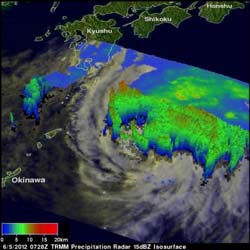NASA satellites see changes in weakening Typhoon Mawar

TRMM data showed Mawar was producing a very large area of rainfall southeast of Japan on June 5, 2012. Most of Mawar's heavy rainfall is revealed by TRMM to be north of the dissipating tropical cyclone's center. The most intense surface rainfall of over 40mm/hr (~1.6 inches) was shown northeast of the center. Much of Mawar's southwestern side was shown becoming rain free. This 3-D image shows that Mawar no longer had an eye wall. Storms near Mawar's center of circulation were reaching to heights of only about 10km (~6.2 miles). The highest storm towers of over 11km (~6.8 miles) were located in a band far to the northwest of Mawar's center.<br>Credit: NASA/SSAI, Hal Pierce<br>
Typhoon Mawar was weakening when the TRMM satellite saw it during the daytime on June 5, 2012 at 0728 UTC (3:28 a.m. EDT/U.S.). Rainfall derived from TRMM's Microwave Imager (TMI) and Precipitation Radar (PR) instruments showed that Mawar was producing a very large area of rainfall southeast of Japan.
Most of Mawar's heavy rainfall is revealed by TRMM to be north of the dissipating tropical cyclone's center. The most intense surface rainfall of over 40mm/hr (~1.6 inches) was shown northeast of the center. Much of Mawar's southwestern side was shown becoming rain free.
A 3-D image from TRMM's PR shows that Mawar no longer had an eye wall. Storms near Mawar's center of circulation were reaching to heights of only about 10km (~6.2 miles). The highest storm towers of over 11km (~6.8 miles) were located in a band far to the northwest of Mawar's center.
NASA's Aqua satellite flew over Typhoon Mawar and the Atmospheric Infrared Sounder (AIRS) instrument captured infrared images from the storm on June 4, 5, and 6 as it expanded, strengthened, rained on the Philippines and headed north in the western North Pacific. Strongest thunderstorms where high cloud top temperatures were colder than -63 Fahrenheit (-52 Celsius). AIRS data now shows that Mawar is now becoming extra-tropical and is interacting with a frontal zone located south of Japan.
At 0900 UTC (5 a.m. EDT) on June 6, Mawar's maximum sustained winds were down to 65 knots (75 mph/120.4 kph). It was located near 28.1 North and 133.5 East, about 110 nautical miles (126.6 miles/ 203.7 kph) north-northeast of Minamidaito, Japan. Mawar is moving northeast at 23 knots (26.4 mph/42.6 kph).
Mawar is expected to stay to the east of Japan and move between the big island and Chichi Jima and Iwo Two. It should continue tracking east-northeast while weakening.
The system is expected to complete extra-tropical transitioning sometime on June 6. It is expected to weaken because of wind shear increasing to greater than 40 knots (46 mph/84 kph) and cool sea surface temperatures, colder than 23 Celsius (73.4F). Sea surface temperatures of 26.6 C (80F) are needed to maintain a tropical cyclone. As Mawar continues moving east-northeast, Japan's big island will likely experience rough surf along east-facing shores.
Media Contact
More Information:
http://www.nasa.govAll latest news from the category: Earth Sciences
Earth Sciences (also referred to as Geosciences), which deals with basic issues surrounding our planet, plays a vital role in the area of energy and raw materials supply.
Earth Sciences comprises subjects such as geology, geography, geological informatics, paleontology, mineralogy, petrography, crystallography, geophysics, geodesy, glaciology, cartography, photogrammetry, meteorology and seismology, early-warning systems, earthquake research and polar research.
Newest articles

High-energy-density aqueous battery based on halogen multi-electron transfer
Traditional non-aqueous lithium-ion batteries have a high energy density, but their safety is compromised due to the flammable organic electrolytes they utilize. Aqueous batteries use water as the solvent for…

First-ever combined heart pump and pig kidney transplant
…gives new hope to patient with terminal illness. Surgeons at NYU Langone Health performed the first-ever combined mechanical heart pump and gene-edited pig kidney transplant surgery in a 54-year-old woman…

Biophysics: Testing how well biomarkers work
LMU researchers have developed a method to determine how reliably target proteins can be labeled using super-resolution fluorescence microscopy. Modern microscopy techniques make it possible to examine the inner workings…





















